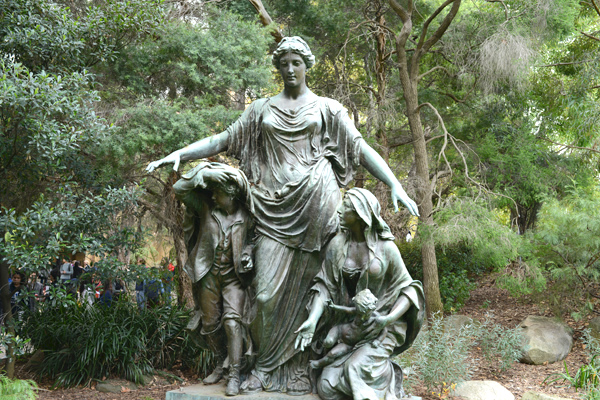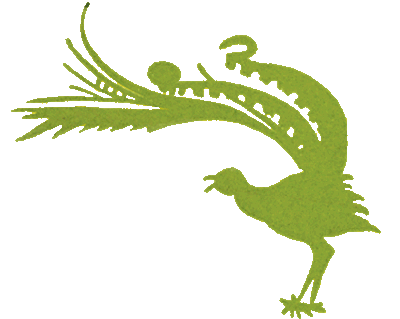
L’OISEAU LYRE
Louise Berta Mosson DYER (19 juillet 1884 – 9 Novembre 1962)
Patron, Benefactress of music and artists.
Music and record publisher, founder of the OISEAU LYRE editions
Louise B.M. DYER has devoted his whole life to music through her life's work:
Les Editions de l’OISEAU LYRE
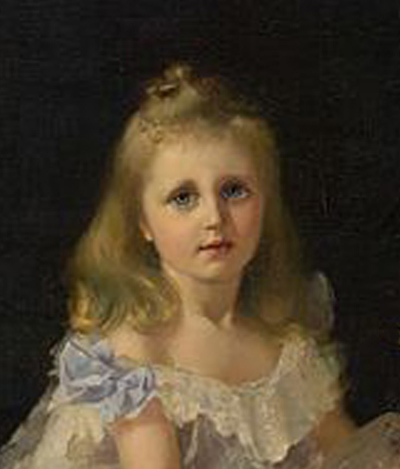
Louise at 4 years old, extract from a portrait of Tom Roberts – 1888
I want to hope that the LYREBIRD will be able to spread its flight without incident through time and space.
(Louise B. M. DYER – 1932)
What do we know of this original, atypical and independent label, whose name and logo, the image of the Australian lyrebird, are linked to microgroove.
Editions de l'OISEAU LYRE is the great work of Louise B. M. DYER.
Even today, DECCA releases recordings under the OISEAU LYRE label.
If Louise has invested so much in the microgroove it is because she strongly believed in it. At the time, by investing in this new technology she thought of perpetuating her label and working to something that would survive her.
By naming the microgroove record Longue Durea, did not she signed her records ?
LD like Longue Durea? Or wouldn't it be LD like Louise DYER?
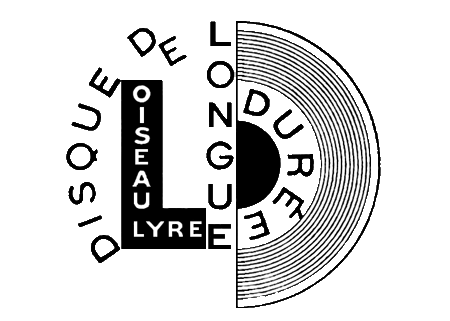
***********************************************
On July 19th, 1884 Louise Berta Mossom SMITH was born into a wealthy family in Melbourne.
She is the daughter of Louis Lawrence SMITH (L.L. SMITH), a well-known physician and member of Parliament of Melbourne and Marion James HIGGINS, his second wife.
From her young age, Louise displays two passions: Music and France.
She spent her childhood in MELBOURNE where she completed her musical studies and obtained her first degree on piano. Thereafter, she left to perfect her musical knowledge in England where she will obtain the gold medal of the Royal Music Academy of London.
As far as France is concerned, she has been very active at the Alliance Française of Melbourne, of which she was a member and President for a few years.
She actively campaigned for the dissemination of French works and French thought.
She had, among other things, set up in Sydney “Forced Marriage” by MOLIERE with music by LULLY.
She also organized concerts mainly oriented early and baroque music.
At the age of 27, on December 27, 1911, Louise married James DYER, 25 years her senior.
James DYER was a wealthy, well-established LINOLEUM representative for Australia.
He was also a great lover of music and a patron himself.
After a honeymoon on the Egyptian Nil, they returned to settle in Melbourne

Louise B. M. DYER - Photo – collection Margarita HANSON.
Louise and James DYER left Melbourne at the end of 1927 to go to England.
They finally settled in Paris in 1928.
Before leaving Australia, Louise funded a number of philanthropic projects, and has helped to the establishment of a symphony orchestra in Melbourne.
Patron passionate about music, in love with France, Louise wanted to do something with her life and had the desire to realize a Great Work that would survive her.
Honorary President of the French Alliance of Victoria, she has always worked to disseminate French thought in her country.
As soon as she arrived in Paris, she became a press correspondent for an Australian newspaper and created what today we would call a network, which allowed her to invite herself everywhere and to have her private entries everywhere, even at the Elysés. (the residence of the French president)
Through her articles she strove to share the French cultural and musical life that she appreciated so much.
In 1932 she created the great work of her life, the Editions de l'OISEAU LYRE.
As a music publisher, Editions de l’OISEAU LYRE was dedicated to the publication of scores, books and musical works.
His favorite field: the publication of early music. Mainly works from the 13th to the 18th century.
The first work consisted of complete publication of works by LULLY and a few other contemporaries. Then Louise tackled the publication of the complete works of François COUPERIN known as “Le Grand” in 12 volumes.
A remarkable edition in the field of music publishing.
In January 1933, Louise wrote a letter, in French, to the President of the French Republic to inform him of her convictions and musical choices and of her regret that François COUPERIN was not more popular in his own country. In this letter, she asks the President of the Republic to kindly honor one of the greatest French musicians: François COUPERIN who, as she says so well, made an exquisite music.
This anthological work has been published to the occasion of the bicentenary (1933) of the death of François COUPERIN. This publication made and still makes today authority in the subject.
Georges DUHAMEL wrote to this occasion:
“This release links your name with the greatest names in French music”.
The first copy of this edition of the complete works of François COUPERIN in 12 volumes was for the President of the French Republic and copy N°2 was given to the library of Melbourne, her hometown.
For this remarkable work Louise will be decorated Knight of the Legion of Honor in 1934. Later, in 1957, she will be promoted to the Order of Officer of the Legion of Honor for his entire career in recognition of his work for French music.
This emblematic work have been a milestone in the annals of music publishing and provided to her recognition, respectability and consecration as a music publisher.
She becomes a personality and essential celebrity of Parisian musical and cultural life.
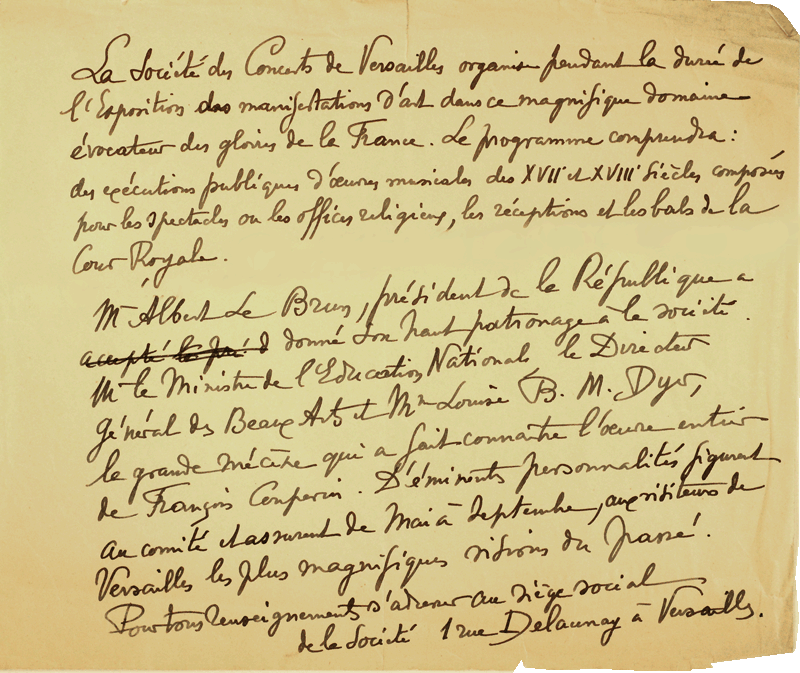
Document archives de l’oiseau Lyre University of Melbourne.
Beneath a “so British” distinction and elegance was hidden a determined woman, eager to serve music.
In 1937, in a letter addressed to a General of French State (we don’t know who he was), she explains her plan which is neither more nor less than a propaganda plan, as she says herself, to bring to light France and French thought.
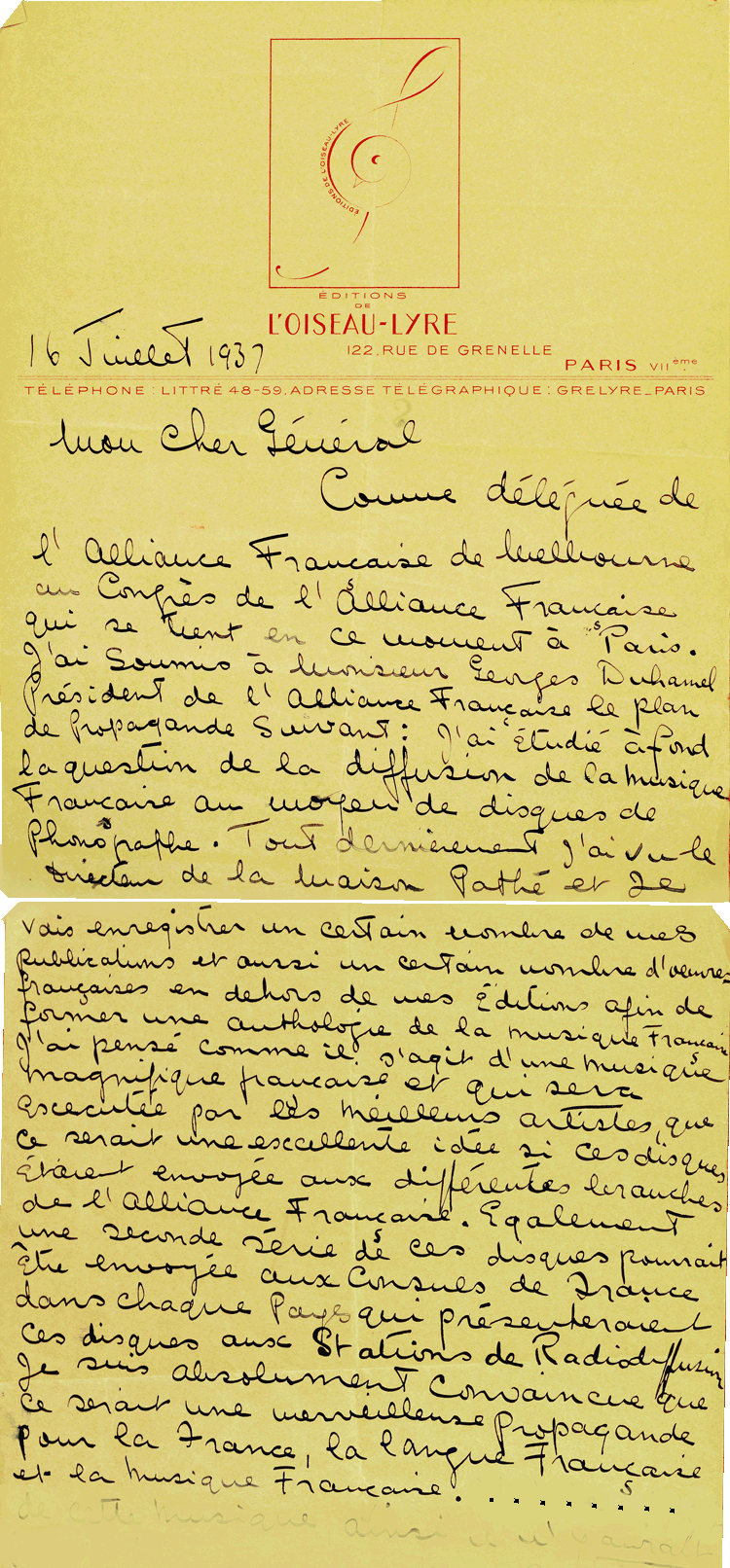
Document archives de l’oiseau Lyre University of Melbourne.
Louise certainly felt more French than many French women by birth.
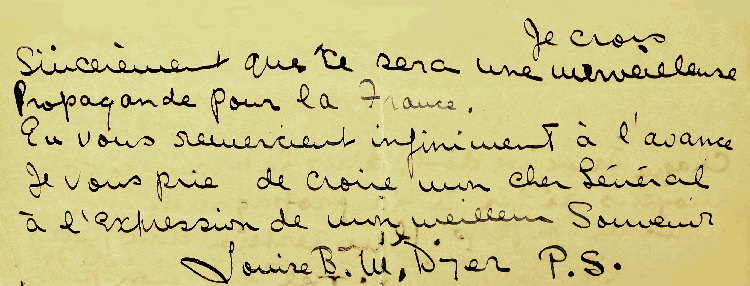
Document archives de l’oiseau Lyre University of Melbourne.
Editions de l'OISEAU LYRE also published many works by other contemporaries of, RAMEAU, LOEILLET, de LALANDE, etc.
For the English Music she did honor to PURCELL and emerge John BLOW out of oblivion.
In 1940 the Editions of l'OISEAU LYRE had published something like 40 volumes of musical works.
In 1937, as she herself said in her letter, desiring to illustrate her own musical publications, she decided to go on recording. She asked to her advised patent and trademark agent to register the OISEAU LYRE trademark and logo for the record industry.
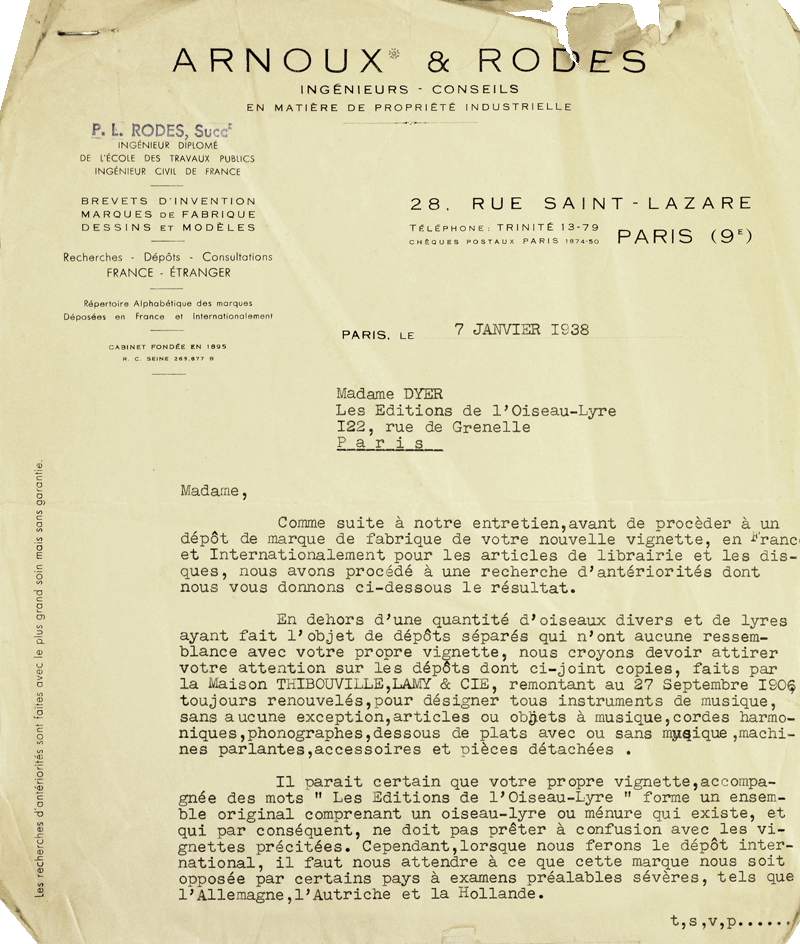
Document archives de l’oiseau Lyre University of Melbourne.
In 1938 she founded the record company Editions de l'OISEAU LYRE.
At first she mainly brought to the disc works of which she held the publication.
As for the press activity, Louise chooses the lyrebird, from her native Australia, as her logo.
The press logo represents a front view lyrebird and record a side view lyrebird.
Subsequently there will be a specific logo for stereophony consisting of 2 side view lyrebirds back-to-back.

The December 22nd 1937, Louise DYER letter to the secretary of concerts du Conservatoire sheds light on the first recording whose repertoire consisted of works by WEBER.
Year 1938, for its first year of existence, the OISEAU LYRE discs edition released several recordings.
First there was the WEBER's record. Then, on July 7th, 1938, the recording of MOZART's LAUDATE DOMINUM with a group of musicians named the Company Mozartsienne.
From October 7th to 21st, 1938 recording took place at PATHE studios.
On October 25th, there is the recording of DE PROFUNDIS by MOZART with the Félix RAUGEL choir and on October 28th, there was the recording of the HAYDN symphony concertante with 30 performers under the direction of MUNCH.
In January 1939, the l'OISEAU LYRE record company had already released some records and Louise B. M. DYER, who wanted to be recognized as a professional, wrote to the secretary of the company of the Concerts du Conservatoire a letter signifying to him:
“I have a lot of projects…
I am established as a music publisher and now as record publisher too, I want to be treated the same way as all other professional publishers”.
This letter was a follow-up to certain salary abuses on the part of musicians taking advantage of Madame DYER's good heart and "amateurism".
January 23rd, 1939, the OISEAU LYRE had recorded a repertoire of chamber music at the PATHE studio under the direction of Mr. FENDLER. The orchestral ensemble is composed of 7 players from the company Concerts du Conservatoire.
On February 14 – 15 – 16 – 20 & 21, 1939, orchestra of Concerts du Conservatoire was reserved for recording by OISEAU LYRE.
February 24, 1939 the OISEAU LYRE organizes a concert in the GAVEAU hall.
April 25, 1939 recording at PATHE studios with the orchestra of Concerts du Conservatoire.
From the outset, the very recent records activity of OISEAU LYRE takes a significant rise. The records become the sound illustration of the paper edition.
James DYER died in January 1938 and Louise remarried in April 1939 to Joseph Birch (Jeff) HANSON who was then professor of French civilization at the University of Oxford.
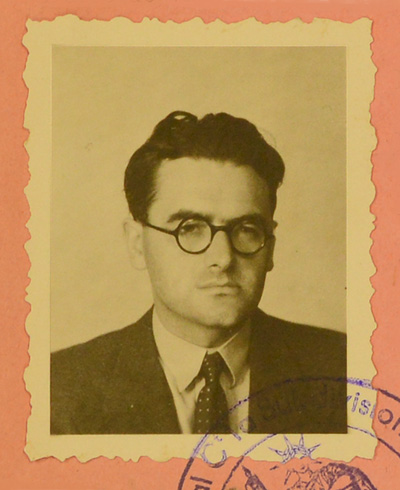
Photo of the driver's license issued in France -Document archives of the Oiseau Lyre University of Melbourne.
Jeff Hanson spent part of his childhood and youth at Melbourne.
At the University of Melbourne he obtained his first doctorate in French literature.
He then continued his studies in France, at the Sorbonne and obtained a second doctorate for his work on the French poet Charles GUERIN.
It is in Paris where he met Louise.
In 1940, OISEAU LYRE publishes records for now 2 years.
France is now at war, which puts a serious brake on activity of OISEAU LYRE company.
Louise left France at the start of the war and the HANSON couple settled in Oxford, at Balliol College, and would remain there during the war years.
It is from there that they manage their activities during this period.
On a transport manifesto from the 1940s we find a customs document attesting to the transport and export, from France to England, of “engraved pewter objects”, a pretty statement to designate disk matrices in circulation between France and England.
Originally, the OISEAU LYRE had its cutting, metal work and pressing of his records made at PATHE in Chatou suburb of Paris.
On March 10, 1940, a letter from Louise DYER suggested the possibility to increase the selling price of the records, to fight against the increase in the manufacturing prices of PATHE.
Paul Jacques PLOIX, in charge of the business of the rue de GRENELLE during these war years, gave his opinion:
“I give you my opinion as you asked me, the cost of the matrices has doubled at PATHE since the end of 1939.
The matrix went from 1,400 F to 2,800 F.
Increasing further the price of records is not necessarily a good idea knowing that the OISEAU LYRE records are already the most expensive on the market.
- The 30 cm record (12”) from ANTHOLOGIE SONORE is sold for 42 F.
- The COLUMBIA & GRAMOPHONE records are available at the price of 40 F.
- I suggest a single price of 35 F for the 25 cm (10”) and 45 F for the 30 cm (12”).
(“F” means French Francs of the time.)
In addition, P.J. PLOIX pointed out to Mrs. DYER that with the events, the prices have been blocked since September 1939. Obtaining a derogation to be able to rise prices is an uncertain obstacle course.
In a letter dated April 14, 1940, Madame DYER continued to complain to Paul Jacques PLOIX about the price increase at PATHE and wondered about what to do.
As an answer, Paul Jacques PLOIX replied:
“PATHE has really raised too much the prices of pressing but he feels strong having no longer competitor in France.
There are only 2 record factories today in France: PATHE and POLYDOR. POLYDOR is a German company with a French name. As the quality of POLYDOR is really inferior, all the orders go to PATHE and all the fine records are made at CHATOU.
At the end of April 1940, P.J. PLOIX announced to Mrs. DYER that further a restock PATHE confirmed that he was granting a 20% discount to OISEAU LYRE. Into the bargain, PATHE did abandoned the minimum quantity of 500 pieces stipulated in original contracts.
Even better, in May 1940 PATHE brought back minimum quantity to 50 copies especially for the OISEAU LYRE. P.J. PLOIX took the opportunity to place a restocking order of only 50 pieces with several references.
Louise and Jeff HANSON returned to France at the end of the war in 1945 but quickly left Paris to settle in Monaco.
At that time, the Paris of the immediate post-war period did not offer the ideal conditions for working peacefully.
The recording discs activity, which had been put aside during the years of conflict resumed.
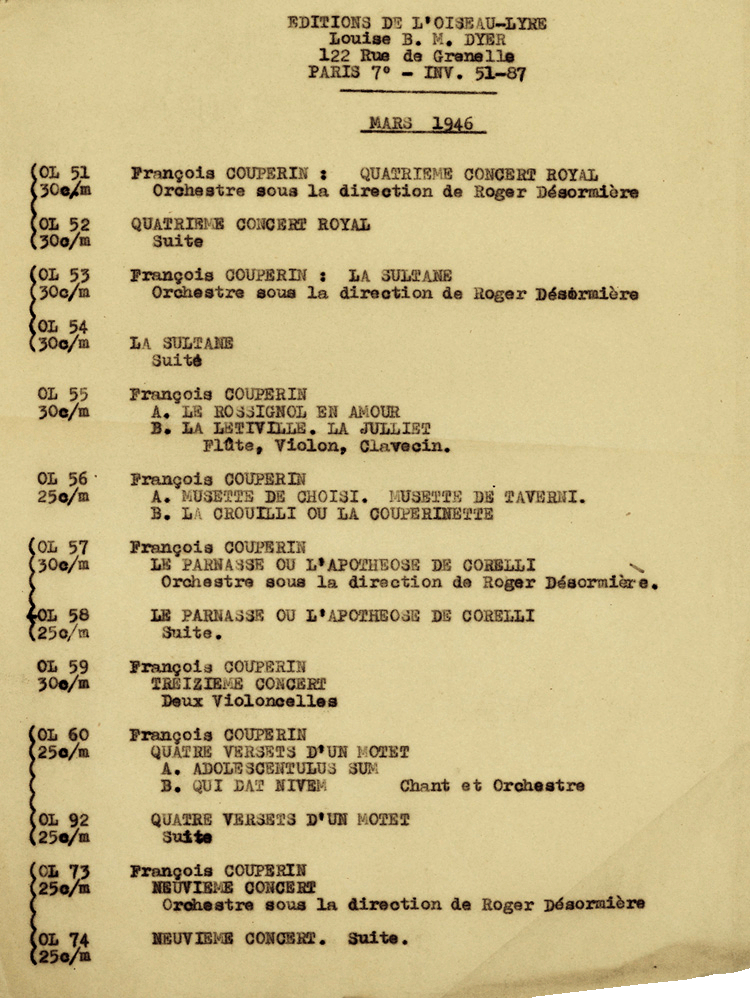
Document archives de l’oiseau Lyre University of Melbourne.
If Louise's business was first and foremost early music, she did not neglect her contemporaries and worked actively on the recognition of young French composers, including Georges AURIC, Benjamin BRITTEN, Joseph CANTELOUBE, Gustav HOLST, Jacques IBERT, Vincent d'INDY, Charles KOECHLIN, Darius MILHAUD, Albert ROUSSEL and Henri SAUGUET.
Before 1949, in the absence of a tape recorder, discs were directly recorded on 78 rpm records.
During the first ten years of the record activity of the editions of OISEAU LYRE Louise worked with little-known artists around the world at the time and recorded conductors like Roger DESORMIERES and Victor DESARZENS and instrumentalists like Isabelle NEF, Jean Pierre RAMPAL, Maurice ANDRE, Robert VEYRON LACROIX, and many others.
Things continue like this until the arrival of the microgroove.
In 1949, André CHARLIN had just stopped to work for cinema.
He sold all his patents to PHILIPS and start a new career and embarked on recording and HiFi electroacoustics.
He created the CHARLIN Laboratories and the CECE, Centre d’Enregistrement des Champs Elysées.
(Champs Elysées Recording Center)

Document archives de l’oiseau Lyre University of Melbourne.
The 78 rpm disc was in “fight” with the new 33 rpm record which was going to win the battle.
People were already talking, for a few months, of a new invention developed by COLUMBIA in the United States which made possible to lengthen the range of recorded music.
If many record companies initially considered the Long Play as a gadget coming from America, it was not the opinion of Louise who had been waiting for a long time to be able to accommodate at least one complete symphonic movement on one side of a record without being obliged to “butcher” it.
She invested her completely in the Long Play and was looking for a company able to achieve “the thing” in France. She was recommended an engineer full of talent whom she did not know, since at this time André CHARLIN was not in the recording industry.
They got on well and decided to work together.
The collaboration between André CHARLIN and OISEAU LYRE started in 1949 at the dawn of the microgroove.
After going around the question with André CHARLIN, Louise embarked in September 1949 for the United States to take a closer look at this famous invention. She carried in her suitcases 78 rpm matrices that she intended to assemble in 33 rpm Long Play.
Louise, who expected a lot from the lengthening of the musical tracks of the records, took an active part in the process of manufacturing the microgroove in France. André CHARLIN had the necessary inventiveness but could not do it alone. By bringing back from the United States specific tools, a stylus and perhaps a cutting head, Louise actively participated in the process to manufacture microgroove in France.
The correspondence does not detail the tools brought back by Louise.
On the other hand, a little later, during a stay of Louise in the United States, André CHARLIN expressly asked her to bring back a stylus for his cutting lathe.
From this collaboration between Louise DYER and André CHARLIN the first French microgroove had arisen at the end of 1949.
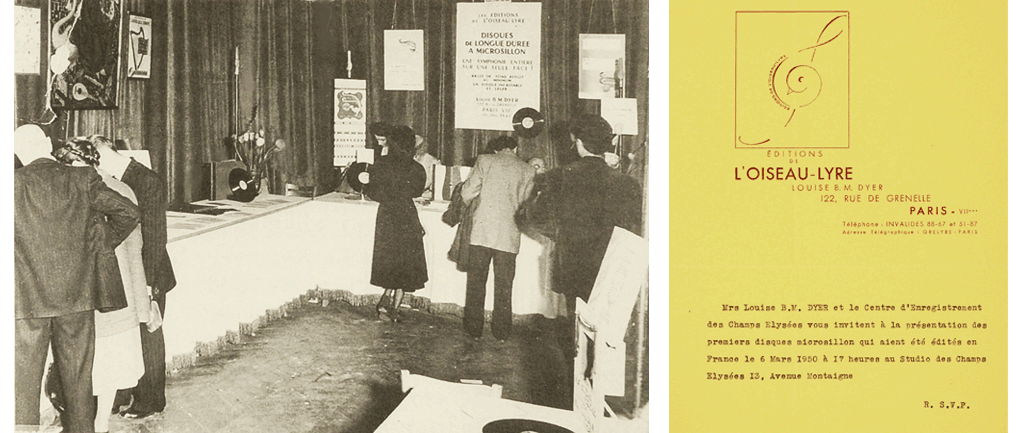 Photo – collection Margarita HANSON.
Photo – collection Margarita HANSON.
The first French microgroove is officially the (Apotheosis) "l’Apothéose de LULLY" by COUPERIN - record OL-LD 1.
Launch will be made with great ceremony on March 6, 1950 at; 5 p.m. at André CHARLIN premises, the CECE 15, avenue Montaigne. (close to Champs Elysées)
In fact, according to André CHARLIN, the first microgroove disc would be the OL LD 2 disc of French folk songs.
For the launch of the French microgroove LP, Louise preferred the COUPERIN repertoire more prestigious than a piano/voice record of French melodies performed by CANTELOUBE and Lucie DAULLENE, an unknown singer, worse than that, a cabaret singer.
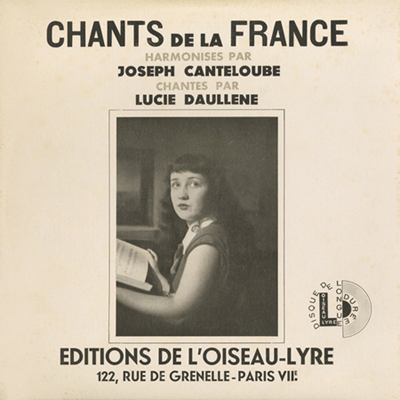
This is how the second "French microsillon" became the first!
In an interview from the 80s André CHARLIN said to have recorded Lucie DAULLENE and having realized the first microgroove record in France and Europe for Mrs. DYER of l'OISEAU LYRE.
The OL-LD 1 record, the apotheosis of LULLY, is entirely concerned by the re-record of 78 rpm material. We can say that this is the first André’s microgroove record released, but the content was not recording by him.
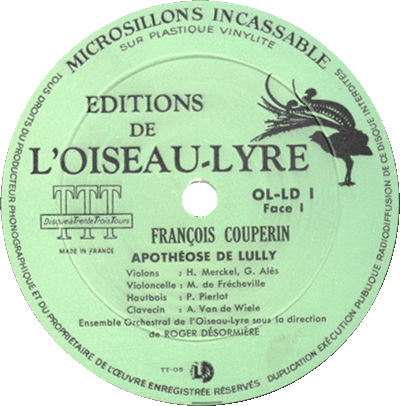
The year 1949 corresponds to the beginning of the use of the tape recorder in the recording industry. Before the advent of the tape recorder, the sole medium was lacquer disc recording at the speed of 78 rpm.
With the variable pitch of the microgroove, the tape recorder became an essential tool.
In the archives we find exchanges between A. CHARLIN and Jeff HANSON concerning re-recordings of 78 rpm on tape in order to make Long Play vinyls.
It is therefore certain that some LP vinyls come from re-recording 78 rpm.
Disc OL-LD 25 of BACH's musical offering by OBRADOUS is an old recording from the early 1940s which was re-recorded. In a letter from February 1951, André CHARLIN explained to Jeff HANSON that the result is very good for a re-recording.
Another LP, which seemed eminently suspect, the OL-LD 10 Hippolyte & Aricie composed by RAMEAU and performed by DESORMIERES, is for its part an original new recording made in France in 1950, just 2 years before the tragic end of the Maestro's career.
To sum up, we do not know where the re-recordings have been used, but for sure re-recordings exist. Did they contribute to complete too short faces, most certainly. Did they give birth to full LP? Maybe, but it is less certain, and today it's too late. We'll never know the truth.
André CHARLIN says that in 1949, at the beginning of his activity in the record industry, the tape recorder “did not exist”. A slightly exaggerated assertion that is not entirely correct. But it is certain that the use of the tape recorder was not yet very widespread and was then very confidential.
Tape recorders, in the form we know today, appeared in 1936 in Germany and were widely used for Nazi propaganda.
It took until 1945 and the end of the war to see the tape recorder leaving the borders of Germany. Initially tape recorders were of quite poor quality. These quality issues have marginalized the tape recorder who struggled against the 78 rpm direct recording.
It is MULLIN, an American soldier, who put his hands on 2 AEG machines and send them, after dismantling, in spare parts to America. In 1948 AMPEX released its first tape recorders which quickly conquered the market. But that's another story.
André CHARLIN’s recording machine was a custom-made device a priori from an AEG mechanical basis with an electronic revisited by himself. Without repeating the scenario of MULLIN/AMPEX in the United States, André CHARLIN partly built his own tape recorder.
At that time, the tape recorder was the object of much hope in the audio business.
1949 / 1950, Louise was very proud to proclaim everywhere that OISEAU LYRE was the only record label to have its own sound engineer who was present from start to finish, from recording to pressing.
There is every reason from supposing that from 1949 to 1956/57 all OL-LD references have been recorded by A. CHARLIN. With the exception of a few rare old 78 rpm records from the 49/50s which would have been re-recorded in microgroove by the CECE of André CHARLIN.
Louise's choice to record, engrave and press French was entirely up to her. deliberate fact. The record company l’OISEAU LYRE was a French company under French law who recorded, cut and pressed its records in France.
To fully understand what was happening at that time, you have to put things in context.
Europe did not yet exist and exchanges between France, the United Kingdom and other countries of the world were taxed by customs.
Recording an orchestra in France, having cutting and pressing performed in France required export the finished record to other countries in the world. You have to pay customs dues on these records at entry into foreign countries.
Have the cutting and the pressing carried out at London only needed to export the master tape or a copy.
This is certainly the reason what led Louise, regardless of notoriety, to work on the go at once in Paris and in London.
The recordings made in Paris by André CHARLIN were cut and pressed in France for the French market. The lacquer cutting was made by André CHARLIN at the CECE and the pressings were carried out at PATHE MARCONI in Chatou.
Copies of the original tapes were exported to London for cuting and pressing in England by DECCA for the rest of the world due to agreement between L’OISEAU LYRE and DECCA.
In 1950, the 4 books of pieces for harpsichord by F. COUPERIN were recorded by GERLIN. That is to say the complete harpsichord music of COUPERIN. Reviews were generally good to excellent.
The critic of the “Observer” considered it the best work for harpsichord to appear in all time. The critic of “Gramophone” considered that it was the first time since COUPERIN himself that someone performed all these pieces.
The magazine “Disques” wondered about the tempi and the quick production of these recordings. Perhaps it would have been better to wait a little, between the publication of the 4 books, so that the performer fully immerses himself in the music, rather than chaining everything together with a sustained rhythm.
In the 1960s Louise was convinced that the entire COUPERIN had to be revisited with a different performance.
The vinylite material used in France for record manufacturing was of poor quality due to importation difficulties.
The material being of lower quality, the finish record was of poor quality too.
The records were thicker, more fragile and the background noise quite high, compared to the records made in England or in the United States.
Following a rather harsh criticism from an English newspaper, Louise began to rally to the idea that it was urgent and necessary to do something.
Louise liked France, but the technical problem had to be solved first.
Making it more international and a little less French can only be beneficial for the reputation of l’OISEAU LYRE.
In 1951, Louise decided to call on the best to cut and press her records: DECCA in London “The most technological advance in the domain”.
In those days, DECCA was an outsider relatively far behind the majors of the time, but that was without counting on the inventiveness and the capacity innovation of this small structure which very quickly became internationally recognized.
DECCA was distributed in the United States under the name of LONDON.
This is how the double catalog of l’OISEAU LYRE appeared with a French reference for the cuttings and pressings made in France for French market and an international reference for the English cuttings and pressings distributed under the name of LONDON OISEAU LYRE in the territories conceded to the DECCA company.
In 1953, l’OISEAU LYRE signed an agreement with DECCA which gave to DECCA, for a certain number of territories in the world, including the United Kingdom, the USA and many European countries, the authorization to press and sell the records of the OISEAU LYRE catalog while respecting the logo, the brand, etc.
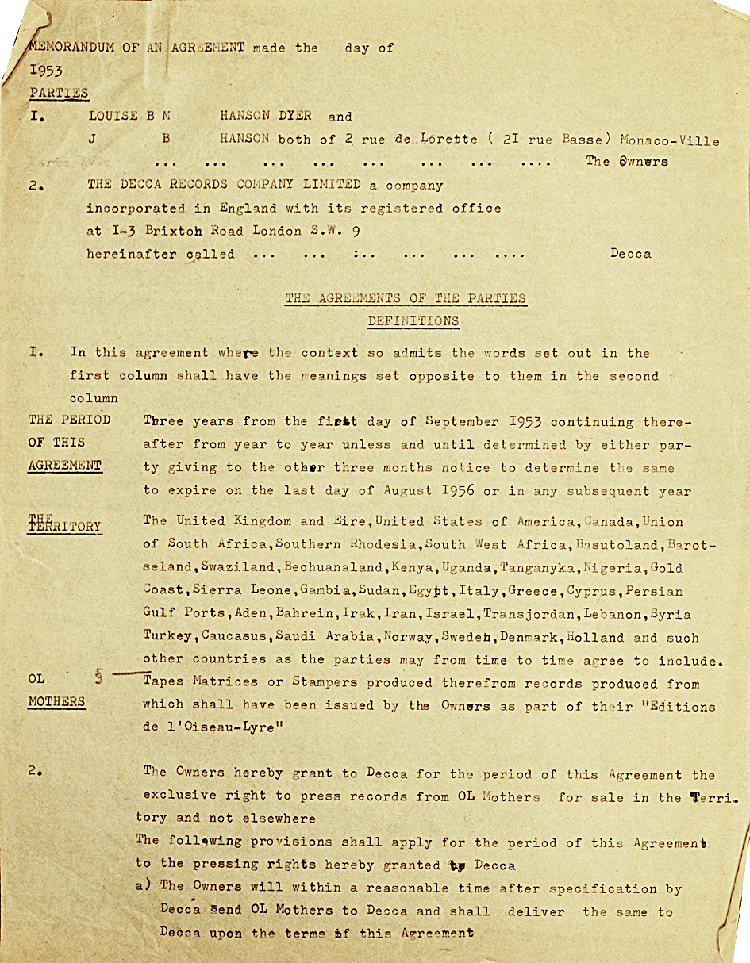
Document archives de l’oiseau Lyre University of Melbourne.
Louise reserved French territory for herself and entrusted, for a certain time, the distribution in France to DUCRETET THOMSON.
The records of l’OISEAU LYRE continue their recordings in France.
From October 16 to 21, 1953, André CHARLIN recorded the harpsicord of Miss Isabelle NEF.
Jeff Hanson's handwritten note from 1954/55 informs us of the various projects in progress with André CHARLIN:
- The passion according to St Matthew
- Mass in B
- Te Deum of Lalande

Stock & Land – Février 1954 - Document archives de l’oiseau Lyre University of Melbourne.
During June 1955, Louise recorded the pieces for harpsichord of RAMEAU by Ruggero GERLIN who was at the time quite comfortable in this more flamboyant repertoire than that of COUPERIN.
Louise then worked on the LULLY repertoire with a Belgian musicologist and with Richard CUDWORTH.
This is how the “LULLISTES” record was born.
In the field of organ music, Louise and Jeff (Joseph HANSON) worked with John EGGINGTON who had already recorded for l’OISEAU LYRE on the organs of MEAUX and POITIERS.
For the BACH Toccatas and Fugues recital project, they had asked to Pierre COCHEREAU titular performer the possibility to record on the organ of St ROCH, authorization which was granted to them free of charge.
At that time, in 1955, Pierre COCHEREAU was appointed titular organist of Notre Dame de PARIS and he granted to l’OISEAU LYRE two years of exclusivity.
Louise wanted Pierre COCHEREAU to record the Romantic repertoire, because he excelled in this register, and moreover, the organ of Notre Dame, which had been restored in 1868, was in excellent condition and perfectly suited to this kind of music.
André CHARLIN was solicited for recordings at Notre Dame de Paris.
It was a rather memorable episode because the reverberation of Notre Dame having proved to be of the order of 8 seconds, it was necessary to install the microphone in suspension by a set of ropes and pulleys in order to be located to the right place to get the right sound and the right atmosphere.
First, VIERNE's second organ symphony was recorded. It was an interpretation of such accuracy that the review “Disques” commented: “Few performers have penetrated the music of VIERNE with so much love and intelligence”.
They then recorded works by DUPRE, also created for the organ of Notre Dame.
Then COCHEREAU abandoned the music specifically devoted to ND's organ to record Fantasia by LISZT, and the preludes and fugues by BACH.
A critic of the review “Disques” not really convinced judged heavy, even “very heavy” interpretation.
It was then Couperin's two masses that were recorded at the Notre Dame de Paris by Pierre COCHEREAU.
But there, as was the case for GERLIN, critics accused him of a certain rigidity and slow tempi.
1957 was the year of the tercentenary of the birth of Michel Richard de LALANDE.
Louise immediately saw an interesting opportunity and undertook the recording of "Music for the King's soupers" with the Orchestra de l'OISEAU LYRE directed by Pierre COLOMBO.
This repertoire had already been recorded in 78 rpm in the past by DESORMIERE.
CUDWORTH for his part selected another suite by Michel Richard de LALANDE, the “Concert of Trumpets for the Fêtes on the Canal of Versailles”, an antecedent to HANDEL's “Water Music”.
That same year, A. CHARLIN produced the first French stereophonic record for l’OISEAU LYRE. The Cantata N° 147 of BACH referenced SOL 60027 (stereo) - OL 50150 (mono).
Recording is done in Paris, the cutting and the pressing are carried out at DECCA London.
Les Indes Galantes by RAMEAU with the Orchestra des concerts Lamoureux under the direction of Louis de FROMENT have been also recorded in stereo by A. CHARLIN– SOL 60024 (Stereo) – OL 50194 (Mono).
In 1957, following her distinction as Officer of the Legion of Honor, she is invited to make a speech during which she retraced 25 years of editions of l’OISEAU LYRE.
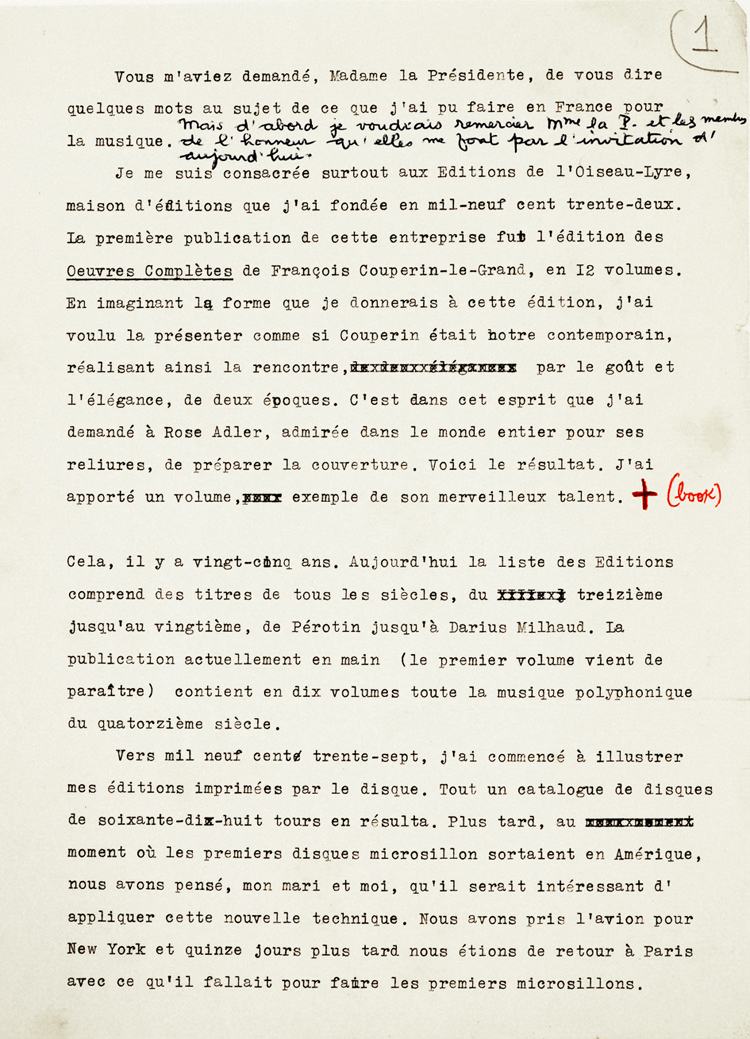

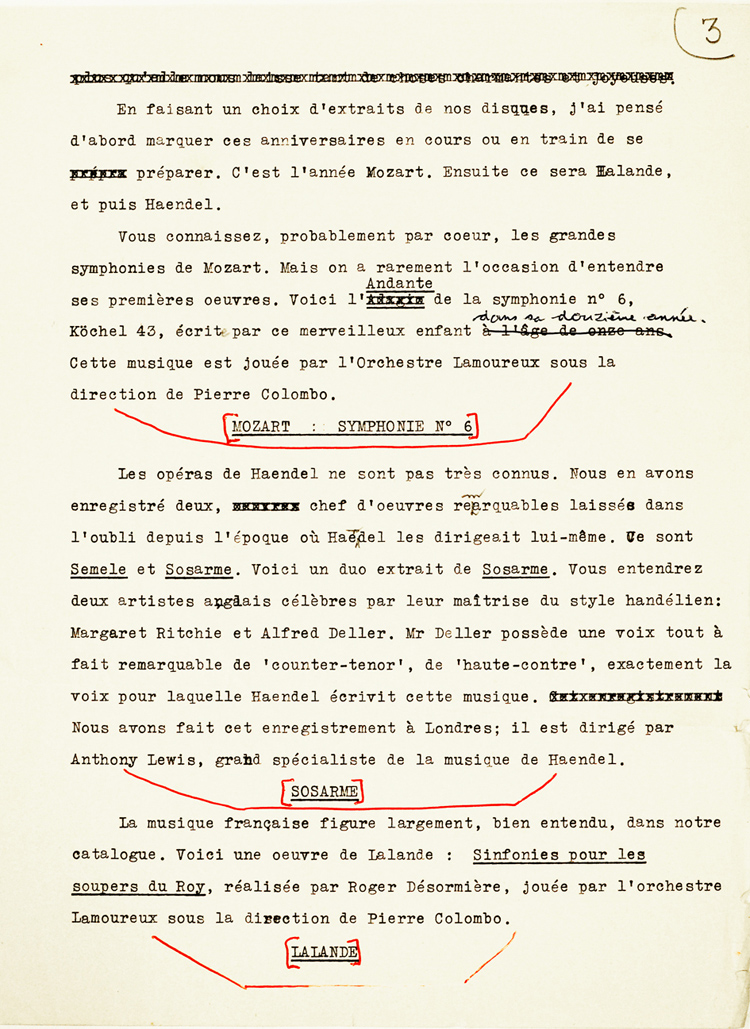
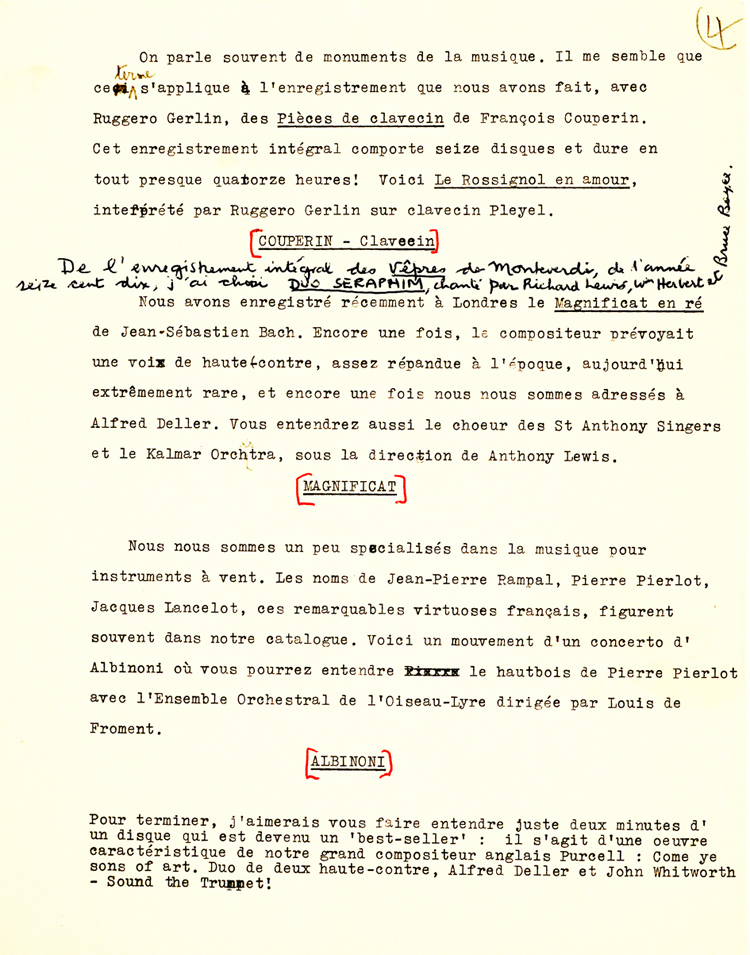
Discours de Louise B. M. DYER de 1957 - Document archives de l’oiseau Lyre University of Melbourne.
Projet de pochette pour les cuivres royaux d’Angleterre OL LD 180 qui obtiendra un grand prix du disque 1959.
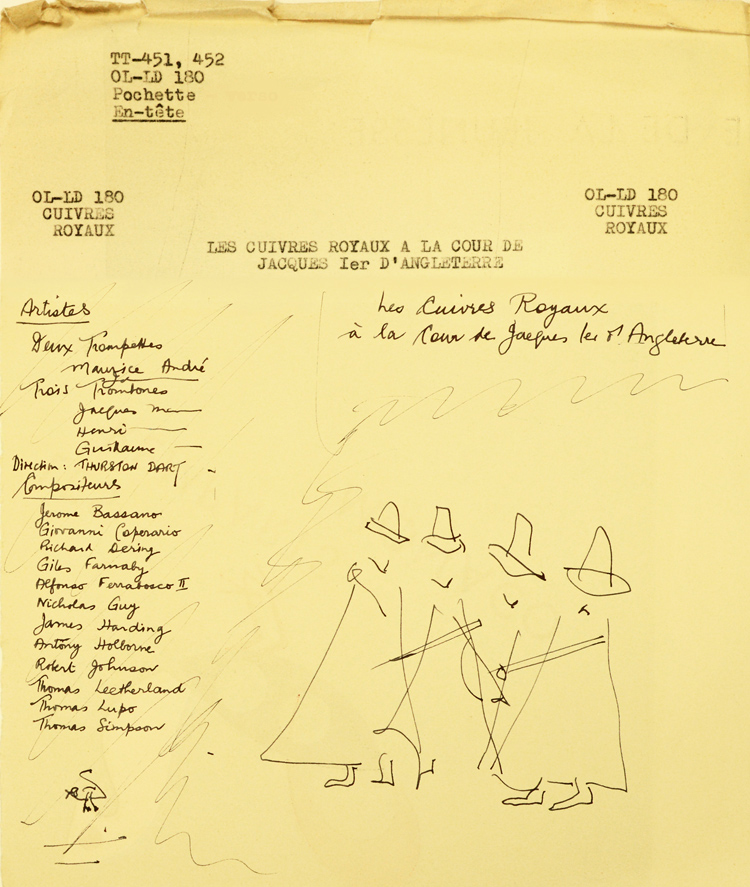
Document archives de l’oiseau Lyre University of Melbourne.
If the decade 1949/59 saw the vast majority of l’OISEAU LYRE recordings made in France by André CHARLIN. But, in the 1960s, the things changed.
Collaboration with French companies had been seriously reduced in the early 1960s.
Louise was exasperated with the existing climate in France and looked unfavourably of being forced to import her own records with taxes of up to 60%.
Decision was made to stop the work in France and to do everything, including the recordings in England at DECCA.
Raymond WARE was appointed coordinator of the work of OISEAU LYRE, a position he will assume until the resumption of the catalog of the OISEAU LYRE in 1970.
Since the 1960s, the few recordings made in France, have not been cut and pressed in France. The original tapes have been sent to London at DECCA which ensured the cutting and the pressing on behalf of the OISEAU LYRE.
The typically French references disappear from the catalog which retains only the international numbering OL 50 XXX.
All the production of OISEAU LYRE records is mainly carried out by DECCA in London, recording, cutting, pressing and marketing.
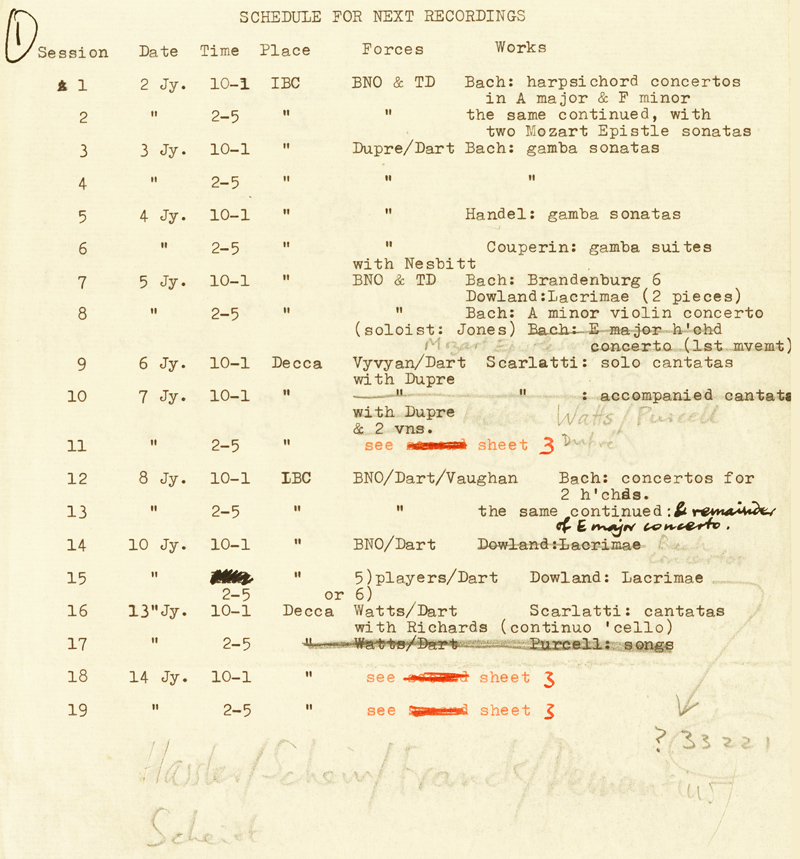
Document archives de l’oiseau Lyre University of Melbourne.
The start of recording in Britain can be dated around late 1957. The main sound engineer was James BURNETT, but Louise frequently complained that DECCA charged assistant for recording sessions for l’OISEAU LYRE.
She also didn't like that DECCA recorded in stereo at a significant cost.
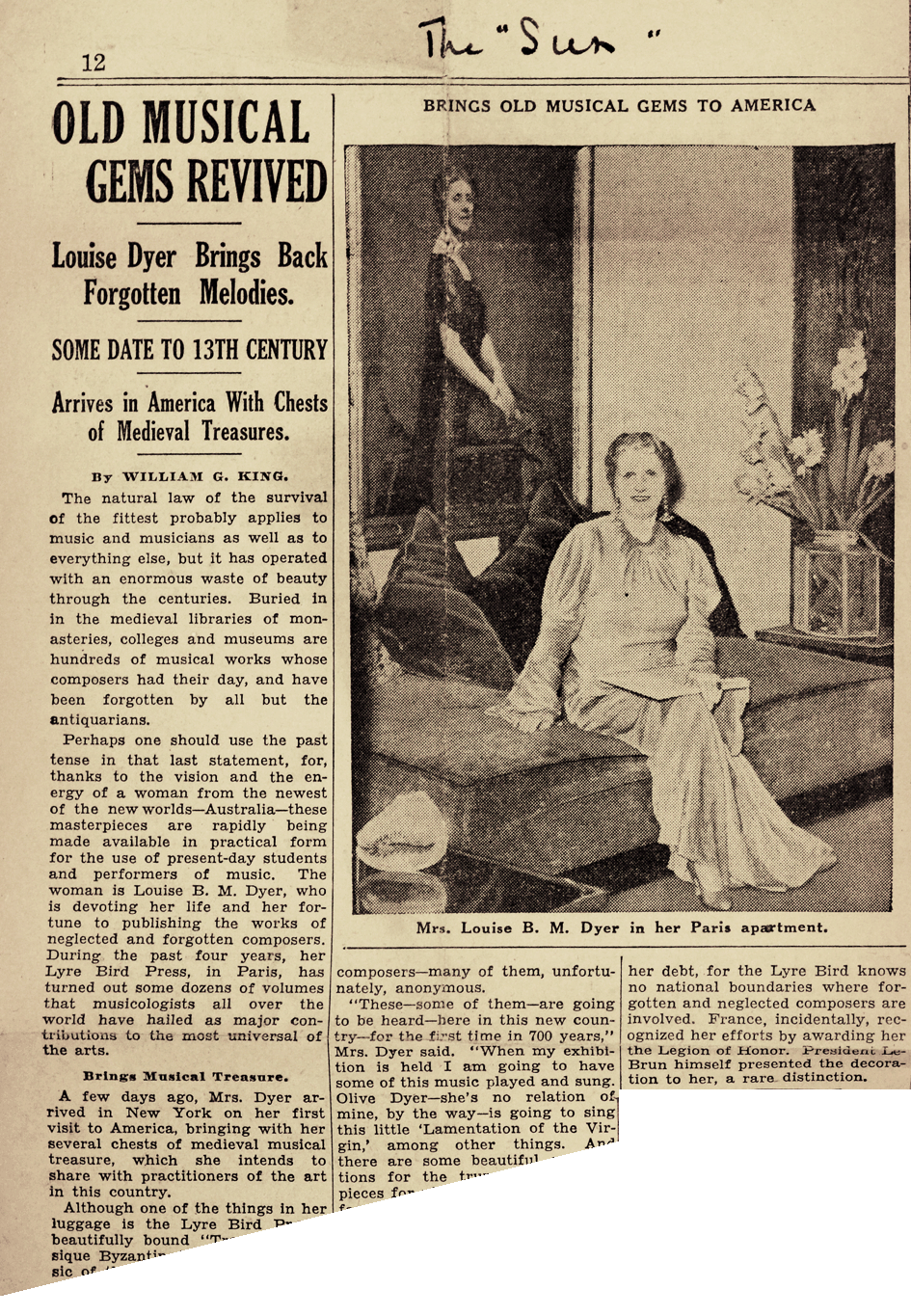
The SUN – 1957 - Document archives de l’oiseau Lyre University of Melbourne.
In 1960, not a “penny” from the United States where historically L’OISEAU LYRE made significant revenues. L’OISEAU LYRE records was selling particularly well there.
Mono discs are no longer sold. Customers want stereo.
The introduction of stereophony turned everything upside down!
The record stores had purely and simply taken the mono recordings out of the shelves to make room for the brand new stereo records.
Louise understood then that something had to be done quicly.
Customers wanted stereophony… We're going to give it to them!
She took the decision to remove many mono recordings from her catalog and to record in stereo from now on.
In the immediate future and to deal with the most urgent, she go around the master tapes and matrices available in order to offer quickly a certain number of recordings eligible for “Stereophonization”… ugh, how ugly! But you have to live.
It would seem that one of the last collaborations between André CHARLIN and L’OISEAU LYRE was the recording of HAYDN’s 88 and 100 symphonies at Opera de Lyon with Alain LOMBARD director. Recording which was far from meeting expectations and which brought serious problems with cutting. In a letter to Jeff HANSON in April 1965, DECCA considered this recording as a failure.
This explains why there are only a few stereo recordings among all records attributable to André CHARLIN.
André CHARLIN said himself: “From the 1960s my clients put me on dry bread”.
It is following this situation that he decided to create his own label in 1962.
Louise died on November 9, 1962 in Monaco.
JB HANSON will say about Louise activity:
“Everything she did was extremely elegant with the main idea of resisting long time. We did not think of the effect nevertheless it was magnificent. »
We use the most beautiful watermarked papers with lyrebird motifs, we employ the best craftsmen to obtain the most beautiful bindings... these limited editions were very beautiful.
In recognition of her work for French music, Louise was decorated Chevallier de la Légion d'Honneur in 1934 and in 1957 obtained the distinction of Officier de la Légion d'Honneur.
Her ashes were repatriated to Australia and buried in Melbourne General Cemetery.
Louise never had an heir. In her will she bequeathed the sum of £240,000 (from 1962) to the university of MELBOURNE, which brought her recognition and the creation of the foundation.
